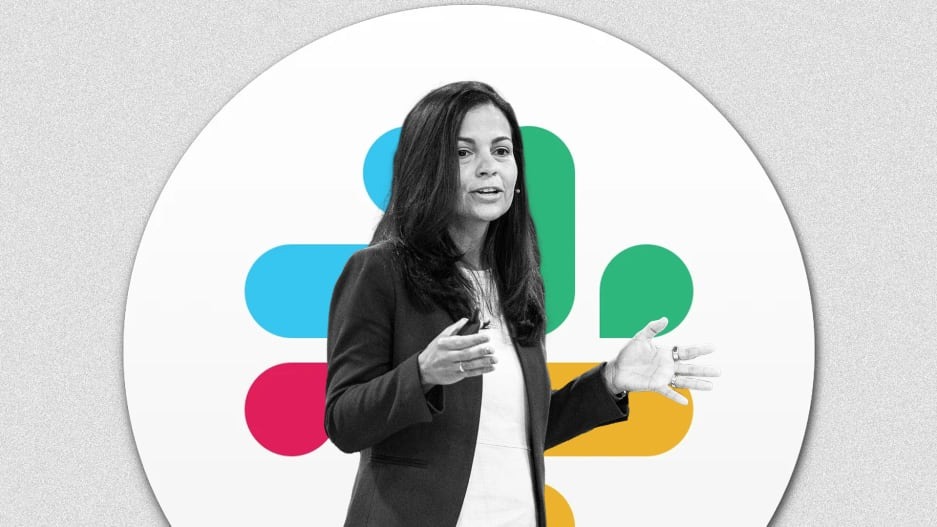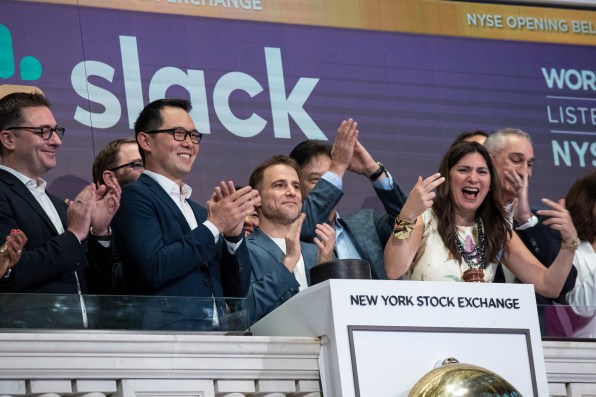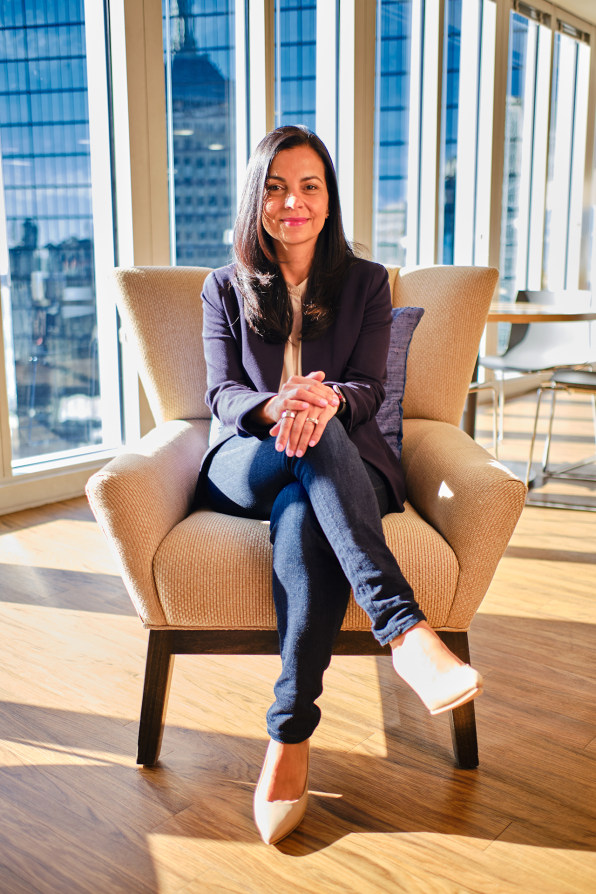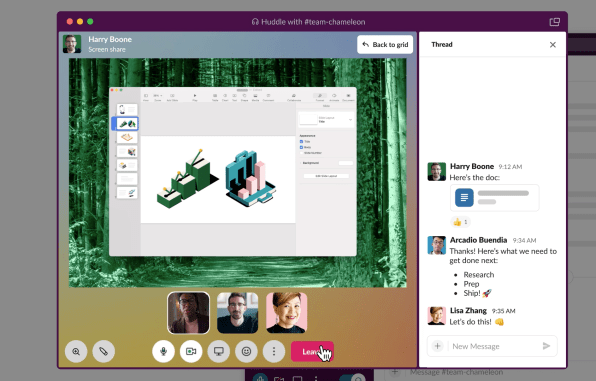- | 2:00 pm
Lidiane Jones, Slack’s new CEO, is the glue between it and Salesforce
Nobody ever said that replacing an iconic founder at a moment of truth for both Slack and Salesforce was going to be easy.

Over a few days in late November and early December of 2022, it became clear that Slack was about to go through a moment of major change, if not outright upheaval.
The first sign came on November 30, when Salesforce co-CEO Bret Taylor, who shared that duty with cofounder Marc Benioff, shocked the tech world with the news he was resigning. Taylor, long among the industry’s most respected product builders, had been widely credited with masterminding Salesforce’s $27.7 billion acquisition of Slack in 2021. One of the most significant new Slack features announced since the merger—Canvas, a collaborative space for sharing text, links, handy automations, and other elements—was even inspired by Taylor’s productivity brainchild Quip, which he’d sold to Salesforce in 2016.
But the bigger bombshell came less than a week later when Slack’s cofounder, CEO, guiding light, and public face, Stewart Butterfield, told his colleagues—in Slack’s own Slack, naturally—that he would leave the company in January. He added that chief product officer Tamar Yehoshua and communications chief Jonathan Prince would also depart. And he got to announce his successor as CEO: Salesforce executive Lidiane Jones.
“So, about this Lidiane,” Butterfield wrote, “You’re going to love her. She’s pragmatic and practical, insightful, passionate, creative, kind, and curious. She’s right at that little diamond-shaped heart in the four-circle Venn diagram of Smart, Humble, Hardworking, and Collaborative . . . She’s one of us.”

For Slack, the “one of us” part of that testimonial was critical. Launched in 2013, the company’s workplace messaging and collaboration platform became the fastest-growing business app ever—not because it offered any unprecedented features, but because it delivered a polished, thoughtful experience that was reminiscent of the best consumer apps. Its approachability made it a boon to organizations of all sorts, and its growth was driven by people actually using and liking it, not IT departments imposing it on anyone. Salesforce, by contrast, was most famous for creating cloud software for specific business verticals and selling the heck out of it.If a Salesforce executive was going to run as atypical a part of the company as Slack, it made sense that she’d be an atypical Salesforce executive. Jones “doesn’t have the classic Salesforce background of having been at Salesforce for 10 years and Oracle before that,” says Slack cofounder and CTO Cal Henderson. Instead of a decade at Salesforce, she’s spent a little over three and a half years there, starting as senior VP for product for its Commerce Cloud line of products and ending up as executive VP and general manager for Commerce Cloud, Experience Cloud, and Marketing Cloud. Moreover, her previous employer was the least Oracle-esque company imaginable: Sonos, the maker of networked whole-home music players.
Just a few weeks into her new job, Jones seems at least as comfortable talking about Slack from the viewpoint of a fan as the person responsible for its destiny. “I’ve loved the product for a long time,” she says. “I was talking to a friend of mine from Sonos about when we embraced Slack. I had this whole spiel about how it’s not a collaboration platform, it’s a cultural transformation! So I was really excited about being part of this product team that has the sensibilities of a consumer product but for enterprise software, which is incredibly unique.”
SHE KNOWS HOW TO NAVIGATE THE LARGER COMPANY BETTER THAN ANY OF US DO, AND SHE UNDERSTANDS SLACK BETTER THAN ANY OF THE SALESFORCE EXECUTIVES DO NOW.”
NOAH WEISS, SLACK CHIEF PRODUCT OFFICER
Along with the challenges that any new CEO would have in succeeding an iconic founder, Jones is taking Slack’s reins at a sobering time for the tech industry in general and Salesforce in particular. In January, the company announced plans to lay off 10% of its staff, a cut that hit Slack as well as its other lines of business. And given the Slack acquisition’s hefty price tag, Wall Street doesn’t think that it has done enough to buoy Salesforce’s overall business. In the fiscal year that ended on January 31, it contributed about $1.5 billion in revenue, around 5% of Salesforce’s total.“I believe sales of Slack have been underwhelming, and likely below the company’s estimates,” says Needham & Company senior research analyst Scott Berg, a situation he attributes to Salesforce salespeople struggling to build Slack into their deals, competition from Microsoft’s Teams, and general headwinds during an uncertain time for the global economy. His skeptical take is not an outlier. In December, The Information published a story by Kevin McLaughlin whose title—”How Slack’s Marriage to Salesforce Crumbled”—conveys its bleak takeaway. Pressure from activist investors has led to chatter that Salesforce could end up shedding Slack to boost profits, though the robust quarterly results it announced on Wednesday might give it more wiggle room to avoid hasty decisions.
Nobody at Slack or Salesforce maintains that the combined company has already figured out exactly how to meld its component parts into something transformative. “I think you could argue we’ve had one of the best track records at integrating companies at Salesforce, integrating the products, and making sure there’s a joint value proposition, but these things just take time,” says Salesforce president and chief product officer David Schmaier. “Slack’s the latest [acquisition], and so it’s a work in progress, and there’s definitely a lot more to do. But I couldn’t be more excited about the future of Slack and Salesforce.”
Jones also argues that it’s too early to render a verdict on Slack’s success as part of Salesforce. “My vision is that we become the core engagement layer for all of Salesforce, for how people engage with Salesforce,” she says. “There should be no starting point besides Slack. And Benioff feels the same way. So we’ve had the most exciting exchanges because, if he could, he would make that happen, like, today. But you know, that’s not the reality for product development.”Turning that vision into reality still sounds daunting. But Jones’ background and skill set might give her as decent a shot as anyone at making it happen. “She knows how to navigate the larger company better than any of us do, and she understands Slack better than any of the Salesforce executives do now,” says Noah Weiss, the seven-year Slack veteran who succeeded Yehoshua as chief product officer.
Michael Affronti, who first worked with Jones at Microsoft and then again when he joined Salesforce in 2021 as a senior VP, has spent more time witnessing her at work than most people. “She has this incredible ability to sit in these executive meetings and just be this glue that connects people in their thinking,” he says. “And I think that’s exactly what Slack is going to benefit from—her helping to connect the vision and the power of that platform with the vision and power and the thinking we have inside some of the traditional Salesforce businesses.”
INTO THE SPOTLIGHT
Though Jones has two decades of experience at major tech companies and was responsible for a sizable chunk of Salesforce’s business in her previous position, her new job is by far the highest-profile one she’s held. A native of São Paulo, she came to the U.S. on a scholarship to earn a computer science degree at the University of Michigan, graduating in 2002. After interning at Apple, she got a job at Microsoft working on automation tools for Excel, the start of an almost 13-year career at the company.
In 2015, in a significant departure from her final area of focus at Microsoft—machine learning cloud services—she shifted to consumer electronics as VP for software management at Sonos. During her time working on streaming music systems, “we agonized over every pixel on every experience and every minor, minor detail on the industrial design,” she remembers. A little under four years later, she pivoted back to business software by joining Salesforce, which promoted her repeatedly.

That background—existing credibility at Salesforce, consumer software skills honed at Sonos, and the Microsoft productivity imprimatur—put her on the list of possible Slack CEOs. “Last fall, Stewart, Bret, and Marc reached out to me about the search,” she remembers. “I hadn’t expected Stewart to retire, honestly. So it was a bit surprising.” Her discussions with Butterfield about the opportunity stretched to multiple meetings and wandered, as conversations with him often do, from topic to topic: her background and theories on how people work, WWII’s influence on office space in corporate America, and Butterfield’s love for the Brazilian musical movement known as Tropicália.
When Jones entered the running, she was an intriguing but somewhat mysterious figure at Slack. “I remember Bret told me very early on after the Slack acquisition, ‘Lidiane, she’s one of the really special ones here—you should get to know her,” says Weiss. Henderson had exchanged pleasantries with her at a Salesforce retreat in Hawaii, but when she emerged as a contender to become Slack CEO, “she seemed interesting, but I didn’t know much about her,” he recalls.
Slack staffers may have been impressed by Jones’ affinity for their product and chops in consumer-grade software experiences. However, her record as a Salesforce executive was also key to her candidacy. As head of Salesforce’s Marketing Cloud, she led the creation of a real-time customer data platform called Genie that Schmaier calls “the fastest growing organically built product in Salesforce history.” Jones, he says, “is a real innovator.”
As Salesforce winnowed its roster of potential Slack CEOs from inside and outside the company, Jones became the favorite. “I spent many hours with a few different candidates,” says Henderson. “I was very involved in the process, and ultimately I loved the decision that we made.”
“THE BIGGEST PRODUCT YEAR FOR SLACK”
At the moment, as she settles into her new job, Jones acknowledges that she’s presiding over a plan that was in the works before her arrival at Slack—one with “three major pillars” for 2023. One is letting non-techie users easily automate common work tasks: “When you actually know what your work is, you’re more empowered to make the best automation tools, as opposed to some centralized IT team,” she says. Another is introducing new forms of knowledge sharing, such as the new Canvas feature, which will be generally available later this year. And the third is connecting people in ways that help them avoid meeting overload, a goal recently reflected in Huddles, which now support impromptu collaboration in both audio and video flavors.

Rather than being new directions, all of these are long-standing areas of interest at the company. For instance, in 2019, I wrote about the introduction of Workflow Builder, a feature that was designed to . . . let non-techie users easily automate common work tasks. But “this is probably going to be the biggest product year for Slack in four or five years, maybe, in terms of changes to the core product experience,” says Henderson. There will presumably be news at Salesforce’s TrailblazerDX conference next week in San Francisco, where Slack will be one of the topics of discussion. On Twitter, Benioff has already been whetting appetites by talking up something with the tantalizing name of EinsteinGPT—whose features will apparently include creating Slack workflows.While there are already some integrations between Slack and other Salesforce products, the vision Jones describes of Slack as an indispensable starting point for Salesforce customers will necessitate additional features the company is still in the process of building. In the spring, it plans to release a feature called Sales Home, which she describes as “a sales-focused solution built within Slack that still keeps Slack being Slack, but also brings [salespeople’s] key areas and experiences within Slack.”

Jones can’t do anything about one basic fact of life for Slack: Since 2016, it has competed against Microsoft Teams, which, as part of Microsoft 365 (née Office 365) is part of a package of apps that vast swaths of the world’s organizations pay for anyhow. Microsoft says that Teams now has 280 million monthly active users. Meanwhile, Slack last reported a total user figure—12 million daily active users—back in 2019, in a blog post that questioned the value of caring about such figures at all. Today, it reports only more finely sliced stats, such as having 200,000 paid customers in total and 77 customers among the Fortune 100.Competing against a product that Microsoft bundles into its suite has never been a breeze, as anyone who ever worked on WordPerfect or Lotus 1-2-3 could tell you; in 2020, when Slack was still an independent company, it filed a complaint with the EU, charging anticompetitive behavior by the software behemoth. But Jones says she sees her former employer’s product as focusing more on videoconferencing than Slack-style collaboration—hinting that products such as Zoom sit more squarely in its blast radius—and that its omnipresence as part of Microsoft 365 doesn’t prevent Slack from making a compelling case for itself. “When we talk to [prospective] customers, we say, ‘Great, I’m glad you have a videoconferencing solution, but you still don’t have the productivity platform that’s centered around the problems that you’re trying to solve,’” she explains.
Nevertheless, the fundamental difficulty of taking on Microsoft helps explain why Slack ended up selling itself to Salesforce in the first place. And Henderson says that his faith in the deal remains intact: “The original goal—the thesis of the acquisition that we can accelerate faster by being part of Salesforce—still rings true.”
Whatever the competitive landscape and potential for further Salesforce integrations, Slack isn’t going to run out of ways to make collaboration more humane. “The pull from the market for the value that they need from Slack has never been stronger than today,” says product chief Weiss. “And the way that we’re going to be meeting that [need], by expanding the capabilities of the role Slack can play in people’s working lives to make them simpler, more pleasant, and more productive.”
One of the best parts of her new job, Jones told me, is talking to people who feel an emotional connection with Slack. “It’s almost the same experience that I had working for Sonos, where people chase me down the street to tell me a love story,” she says. Lovability made Slack a hit nearly a decade ago—and it might still be the key to its future.






































